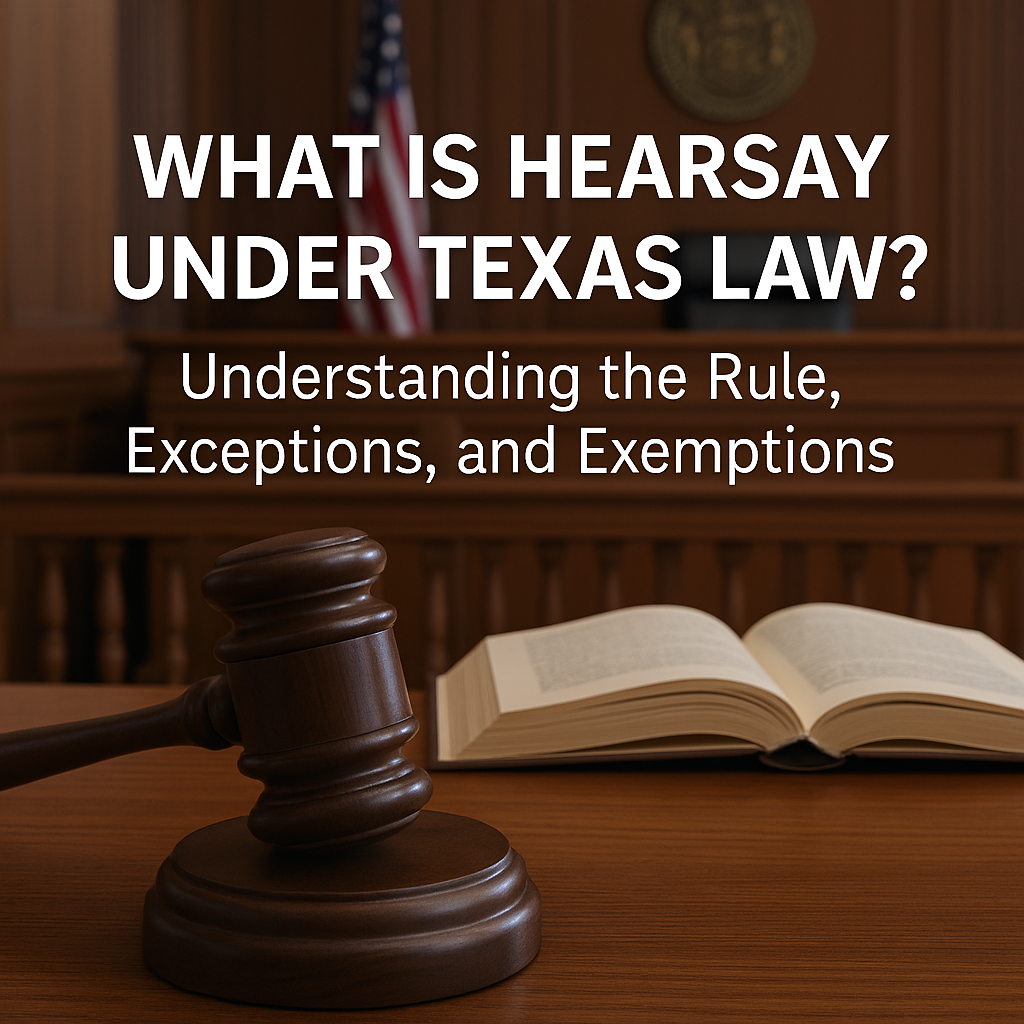
In Texas courts, few evidentiary rules are as widely invoked — or misunderstood — as the hearsay rule. The term “hearsay” often surfaces in courtroom dramas, but its legal definition and real-world application are much more precise. Understanding what constitutes hearsay, when it is excluded, and when it is not excluded is essential for any litigant, lawyer, or witness preparing for trial in Texas.
What Is Hearsay?
Under Rule 801(d) of the Texas Rules of Evidence, hearsay is defined as:
“A statement that (1) the declarant does not make while testifying at the current trial or hearing; and (2) a party offers in evidence to prove the truth of the matter asserted in the statement.”
In simple terms, hearsay is an out-of-court statement — whether spoken, written, or implied — that is being offered to prove what it says. For example, if a witness testifies, “My neighbor told me the defendant was speeding,” that is hearsay if used to prove that the defendant was actually speeding.
Because the declarant (the person who made the original statement) cannot be cross-examined in court, hearsay is generally considered unreliable — and therefore, inadmissible.
Why Hearsay Is Generally Not Allowed
The purpose of the hearsay rule is fairness. The rules of evidence are designed to ensure that testimony presented in court is subject to cross-examination, so that its credibility can be tested. When a person makes a statement outside of court, the opposing party has no opportunity to probe the declarant’s memory, perception, or honesty. Thus, unless an exception or exemption applies, hearsay is excluded.
Exemptions — Statements That Are Not Hearsay
Certain statements that might look like hearsay are explicitly excluded from the hearsay definition under Rule 801(e). Common examples include:
- Party-Opponent Admissions:
A statement made by a party, and offered against that same party, is not hearsay. For example, a defendant’s own confession or damaging statement may be admissible. - Prior Statements by Witnesses:
○ Prior Inconsistent Statements: If made under oath in a prior proceeding.
○ Prior Consistent Statements: Used to rebut an allegation of fabrication.
○ Prior Identifications: A witness’s prior identification of a person after perceiving them.
These are considered exemptions, not exceptions, because they fall outside the definition of hearsay itself.
Exceptions — When Hearsay Is Admissible
Even if a statement is hearsay, it may still be admitted under one of the many exceptions listed in Rules 803, 804, and 807 of the Texas Rules of Evidence. Some of the most common include:
1. Present Sense Impression (Rule 803(1))A statement describing or explaining an event or condition made while the declarant was perceiving it or immediately thereafter. Example: “That car is running the red light!”
2. Excited Utterance (Rule 803(2))A statement made under the stress of excitement caused by a startling event. Example: A victim shouting, “He’s got a gun!” during a robbery.
3. Statements for Medical Diagnosis or Treatment (Rule 803(4))Statements made to a doctor or healthcare provider describing symptoms, cause, or history for the purpose of diagnosis or treatment.
4. Business Records (Rule 803(6))Records of regularly conducted business activity, such as invoices or medical charts, if properly authenticated.
5. Public Records (Rule 803(8))Records or reports of public offices that describe activities, observations, or factual findings under a duty imposed by law.
6. Former Testimony (Rule 804(b)(1))If a witness is unavailable, their prior testimony from another proceeding may be admissible, provided the opposing party had an opportunity to cross-examine.
7. Statement Against Interest (Rule 804(b)(3))A statement so prejudicial to the declarant’s own interest that a reasonable person would not have made it unless it were true.
8. Dying Declaration (Rule 804(b)(2))A statement made by a declarant believing death to be imminent, concerning the cause or circumstances of what they believed to be impending death.
9. The Residual Exception (Rule 807)A “catch-all” provision that allows admission of certain hearsay statements not specifically covered by other exceptions if they possess equivalent guarantees of trustworthiness and serve the interests of justice.
How Texas Courts Apply the Hearsay Rule
Texas judges enjoy significant discretion in determining whether a statement qualifies as hearsay and whether an exception applies. In practice, much of the battle occurs in pretrial motions or sidebar objections. The key is always the purpose for which the statement is offered — if it is not offered for its truth (e.g., to show notice, state of mind, or effect on the listener), it may not be hearsay at all.
Conclusion
Hearsay is one of the most fundamental — and frequently litigated — evidentiary concepts in Texas law. Whether a statement qualifies as hearsay, or falls within one of its many exceptions or exemptions, can make or break a case. Knowing these distinctions allows attorneys to protect their clients’ rights, preserve the integrity of trial testimony, and ensure that only reliable evidence reaches the jury.
At David C. Barsalou, Attorney at Law, PLLC, we help clients navigate business, family, tax, estate planning, and real estate matters ranging from document drafting to litigation with clarity and confidence. If you’d like guidance on your situation, schedule a consultation today. Call us at (713) 397-4678, email barsalou.law@gmail.com, or reach us through our Contact Page. We’re here to help you take the next step.